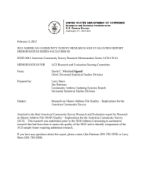
An official website of the United States government
Here’s how you know
Official websites use .gov
A .gov website belongs to an official government organization in the United States.
Secure .gov websites use HTTPS
A lock (
) or https:// means you’ve safely connected to the .gov website. Share sensitive information only on official, secure websites.
-
//
- Census.gov /
- Library /
- Census Working Papers /
- Research on Master Address File Quality - Implications for the ACS
Research on Master Address File Quality - Implications for the American Community Survey
Research on Master Address File Quality - Implications for the American Community Survey
There appears to be both overcoverage and undercoverage in the American Community Survey housing unit frame. Overall, American Community Survey housing unit counts are consistently higher than housing unit estimates and various measures of "truth." National gross overcoverage was estimated at 10.2 percent and gross undercoverage at 6.4 percent. The largest component of undercoverage is units that are missing from the Master Address File altogether.
Undercoverage in rural areas, particularly those areas experiencing growth, is an issue. The Frame Assessment for Current Household Surveys National Evaluation estimated the gross undercoverage in current survey area frame blocks to be near 50 percent. The growth in noncity-style addresses on the Delivery Sequence File may be able to be used to target areas of high growth in rural areas. More research on this is necessary.
Undercoverage of new construction exists outside of rural areas as well. The Delivery Sequence File eventually includes much of the new construction, but processing lags from the time a new construction address appears in the Delivery Sequence File until the time the American Community Survey uses the address results in undercoverage.
Mobile homes also have a high undercoverage rate, regardless of whether they are located in rural areas or other areas.
Overcoverage is likely due to the inclusion of certain categories of Delivery Sequence File records; but removing whole classes of Delivery Sequence File records could increase the already high undercoverage rate of new construction addresses. The use of various classes of Delivery Sequence File addresses (particularly Excluded from Delivery Statistics records) merits further research.
Further research into the definition of the "duplication zone" (areas where Delivery Sequence File records are not used because of an unacceptable risk of duplication with existing addresses) needs to be done to identify areas where the American Community Survey should expand or discontinue the use of new Delivery Sequence File addresses. County-level growth rates should be included in the definition of the duplication zone.
Results from the 2010 Census address canvassing operation should be used to assess various categories of addresses. Using the address canvassing results as ground truth could allow us to determine if there are types of records in the American Community Survey housing unit frame that are more likely to represent overcoverage than others. At the same time we can examine the 2 addresses added by address canvassing that matched to other records in the Master Address File to determine if there are categories of addresses in the Master Address File being excluded by the filter that we should be including.
Others in Series
Working Paper
Working Paper
Working Paper
Share
Some content on this site is available in several different electronic formats. Some of the files may require a plug-in or additional software to view.
 Yes
Yes
 No
NoComments or suggestions?


Top

